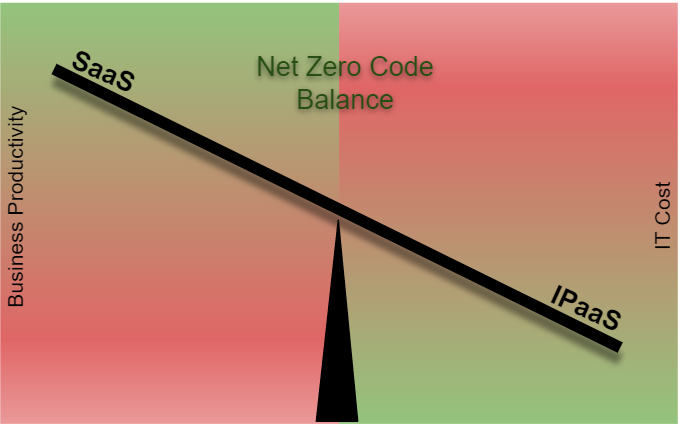There is large-scale skepticism about the ability of governments and organizations to meet net-zero emissions targets. Emissions reductions, recycling practices, and the myriad of changes required for a sustainable world and business operations will significantly impact governments and organizations everywhere. Fundamental to this sustainable transition is a mindset shift to new ways of sustainable thinking that those of us in the IT world can adopt to balance and reduce our tech debt.
In this blog, I’ll cover how IT teams can shift to a more sustainable mindset and implement something I call “net-zero code integration.” Net-zero code integration is not just about saving money on IT projects. It’s about implementing a “clicks, not code” model so your company can quickly deliver solutions and be more responsive and engaged in business needs.
Similarities between a sustainable planet and sustainable IT
The parallels between a sustainable planet and sustainable IT services are considerable. Some examples of this could be building bespoke software or customizing applications that aren’t renewable or reusable. These one-off projects pollute your IT environment, long after the benefits have been consumed.
The planet has a finite amount of resources and many of these resources have harmful impacts when used. An organization has finite IT resources and using these resources to deliver bespoke systems and solutions that could have been delivered by commercial software is unsustainable and unscalable.
Historically, without the proven results and software reuse of iPaaS, Integration platform as a service, integration was difficult and built around a culture of “spaghetti architecture.” With this culture, organizations have to reinvent the wheel every time they have a new project or deliverable. However, the sustainable approach is to consume proven business applications, integrate efficiently through reuse, and customize only where necessary.
Similar to renewable energy sources and more sustainable products, SaaS (software as a service) and iPaaS are allowing the delivery of sustainable IT. What’s more, IT systems need to adapt to meet the broader net-zero and sustainability goals. This often requires software and systems that have “Yet to Exist” to meet new sustainability compliance in areas such as emissions, packaging, recyclables, and “right to repair” products.
The ability for IT to deliver the systems of the future requires a sustainable IT approach that is underpinned by software as a service and integration platform as a service.
Adding more code is a debit (not a credit) on your tech debt balance
The parallels between IT and broader sustainability don’t end there. The path to change and the transition to a more sustainable model are also major challenges. Organizations are often intimidated by modernizing legacy IT systems and sometimes unsure how to move to a hybrid approach.
To make this change, the answer is quite simple, although it does require a mindset shift. Organizations need to consider all systems and software as if they are SaaS and connected by iPaaS, even if it is not yet SaaS or seamlessly integrated. Legacy solutions and applications can be wrapped in an iPaaS layer that delivers this capability to the enterprise in a manner that can be replaced by sustainable alternatives, as they become available or feasible.

Many SaaS solutions have “APIs” that allow integration. However, these solutions are nowhere near net-zero code. In some cases, they can involve considerable customization to integrate with other applications if there is not a connector or a proven reusable integration pattern. If you cannot reuse components, iPaaS generally simplifies the customization and creates a custom connector and not a customized application.
The path to sustainable IT and net-zero additions to the tech debt balance
So the path to sustainable IT requires three streams and an integration portfolio approach. Those three streams should be prioritized in the following order.
- Use net-zero code applications with an iPaaS connector and consume as a service.
- For SaaS and applications that have APIs, use iPasS to make them net-zero code and invest development effort in a custom connector instead of customizing your applications or SaaS.
- Wrap your custom code and legacy in-house applications with connectors and modularize them with APIs, and then connect to other systems using iPaaS.
Conclusion
There’s so much we can learn from the global Net Zero sustainability efforts. When we apply that sustainability mindset to other parts of our world, we can learn to reduce, reuse, and recycle to save resources like time, money, and energy.
IT teams need to embody a culture of reuse in their integration strategy to set themselves up for long-term payoff with a more sustainable model. To do so, IT teams need to have a clear picture of their IT portfolio. They need to understand the tech debt and identify underutilized applications and gaps. From there they can develop a plan to achieve their net-zero code target date. Let’s hope it’s long before 2050!
To learn more about how IT teams are adopting more sustainable practices to keep up with the ever-growing business needs, check out our 2022 Connectivity Benchmark Report.









